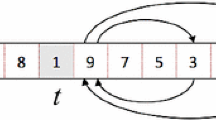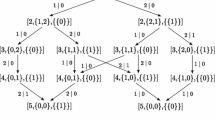Abstract
In this paper, the problem of sequencing mixed-model assembly lines in case of fixed rate launching and closed stations is considered. The problem consists of finding an intermixed sequence of different models of a basic product, which are jointly produced on an assembly line, such that customer demands are fulfilled and total work overload is minimized. For solving this problem an informed tabu search procedure with a pattern based vocabulary building strategy is developed. Computational tests demonstrate that considerable improvements are obtained by comparison to methods which do not incorporate such an approach.
Similar content being viewed by others
References
Bard, J.F., E. Dar-El, and A. Shtub. (1992). “An Analytic Framework for Sequencing Mixed Model Assembly Lines,” International Journal of Production Research30, 35-48.
Bard, J.F., A. Shtub, and S.B. Joshi. (1994). “Sequencing Mixed-Model Assembly Lines to Level Parts Usage and Minimize Line Length,” International Journal of Production Research32, 2431-2454.
Baybars, I. (1986). “A Survey of Exact Algorithms for the Simple Assembly Line Balancing Problem,” Management Science32, 909-932.
Bolat, A. (1994). “Sequencing Jobs on an Automobile Assembly Line: Objective and Procedure,” International Journal of Production Research32, 1219-1236.
Bolat, A., M. Savsar, and M.A. Al-Fawzan. (1994). “Algorithms for Real-Time Scheduling of Jobs on Mixed Model Assembly Lines,” Computers & Operations Research21, 487-498.
Bolat, A. and C.A. Yano. (1992a). “Scheduling Algorithms to Minimize Utility Work at a Single Station on a Paced Assembly Line,” Production Planning & Control3, 393-405.
Bolat, A. and C.A. Yano. (1992b). “A Surrogate Objective for UtilityWork in Paced Assembly Lines,” Production Planning & Control3, 406-412.
Dar-El, E.M. (1978). “Mixed-Model Assembly Line Sequencing Problems,” OMEGA6, 313-323.
Dar-El, E.M. and S. Cucuy. (1977). “Optimal Mixed-Model Sequencing for Balanced Assembly Lines,” OMEGA5, 333-342.
Domschke, W., A. Scholl, and S. Voß. (1997). Produktionsplanung-Ablauforganisatorische Aspekte. 2nd edition, Berlin: Springer.
Gilmore, P.C. and R.E. Gomory. (1961). “A Linear Programming Approach to the Cutting-Stock Problem,” Operations Research9, 849-859.
Gilmore, P.C. and R.E. Gomory. (1963). “A Linear Programming Approach to the Cutting-Stock Problem-Part II,” Operations Research11, 863-888.
Glover, F. (1989). “Tabu Search-Part-I,” ORSA Journal on Computing1, 190-206.
Glover, F. (1990). “Tabu Search-Part II,” ORSA Journal on Computing2, 4-32.
Glover, F. (1996a). “Tabu Search and Adaptive Memory Programming-Advances, Applications and Challenges.” In R.S. Barr, R.V. Helgason, and J.L. Kennington (eds.), Interfaces in Computer Science and Operations Research. Boston: Kluwer Academic Publishers.
Glover, F. (1996b). Private communication.
Glover, F. and M. Laguna. (1993). “Tabu Search.” In C.R. Reeves (ed.), Modern Heuristic Techniques for Combinatorial Problems. Oxford: Blackwell, pp. 70-150.
Glover, F. and M. Laguna. (1997). Tabu Search. Boston: Kluwer Academic Publishers.
Gouveia, L. and S. Voß. (1995). “A Classification of Formulations for the (Time-Dependent) Traveling Salesman Problem,” European Journal of Operational Research83, 69-82.
Inman, R.R. and R.L. Bulfin. (1991). “Sequencing JIT Mixed-Model Assembly Lines,” Management Science37, 901-904.
Miltenburg, J. (1989). “Level Schedules for Mixed-Model Assembly Lines in Just-in-Time Production Systems,” Management Science35, 192-207.
Miltenburg, G.J. and T. Goldstein. (1991). “Developing Production Schedules which Balance Part Usage and Smooth Production Loads for Just-in-Time Production Systems,” Naval Research Logistics38, 893-910.
Ng, W.C. and K.L. Mak. (1994). “A Branch and Bound Algorithm for Scheduling Just-in-Time Mixed-Model Assembly Lines,” International Journal of Production Economics33, 169-183.
Okamura, K. and H. Yamashina. (1979). “A Heuristic Algorithm for the Assembly Line Model-Mix Sequencing Problem to Minimize the Risk of Stopping the Conveyor,” International Journal of Production Research17, 233-247.
Rochat, Y. and E.D. Taillard. (1995). “Probabilistic Diversification and Intensification in Local Search for Vehicle Routing,” Journal of Heuristics1, 147-167.
Scholl, A. (1999). “Balancing and Sequencing of Assembly Lines.” 2nd Edition, Heidelburg: Physica.
Scholl, A. and R. Klein. (1997). “SALOME: A Bidirectional Branch and Bound Procedure for Assembly Line Balancing,” INFORMS Journal on Computing9, 319-334.
Scholl, A. and S. Voß. (1996). “Simple Assembly Line Balancing-Heuristic Approaches,” Journal of Heuristics2, 217-244.
Stadtler, H. (1990). “A One-Dimensional Cutting Stock Problem in the Aluminium Industry and its Solution,” European Journal of Operational Research44, 209-223.
Sumichrast, R.T., R.S. Russell, and B.W. Taylor. (1992). “A Comparative Analysis of Sequencing Procedures for Mixed-Model Assembly Lines in a Just-in-Time Production System,” International Journal of Production Research30, 199-214.
Thomopoulos, N.T. (1967). “Line Balancing-Sequencing for Mixed-Model Assembly,” Management Science14, B59-B75.
Tsai, L.-H. (1995). “Mixed-model Sequencing to Minimize Utility Work and the Risk of Conveyor Stoppage,” Management Science41, 485-495.
Voß, S. (1994). “Tabu Search in Manufacturing.” In H. Dyckhoff, U. Derigs, M. Salomon, and H.C. Tijms (eds.), Operations Research Proceedings 1993. Berlin: Springer, pp. 183-194.
Wester, L. and M. Kilbridge. (1964). “The Assembly Line Model-Mix Sequencing Problem,” Proceedings of the 3rd International Conference on Operations Research. Oslo 1963, Paris: Dunod, pp. 247-260.
Yano, C.A. and A. Bolat. (1989). “Survey, Development, and Application of Algorithms for Sequencing Paced Assembly Lines,” Journal of Manufacturing and Operations Management2, 172-198.
Yano, C.A. and R. Rachamadugu. (1991). “Sequencing to Minimize Work Overload in Assembly Lines with Product Options,” Management Science37, 572-586.
Author information
Authors and Affiliations
Rights and permissions
About this article
Cite this article
Scholl, A., Klein, R. & Domschke, W. Pattern Based Vocabulary Building for Effectively Sequencing Mixed-Model Assembly Lines. Journal of Heuristics 4, 359–381 (1998). https://doi.org/10.1023/A:1009613925523
Issue Date:
DOI: https://doi.org/10.1023/A:1009613925523




